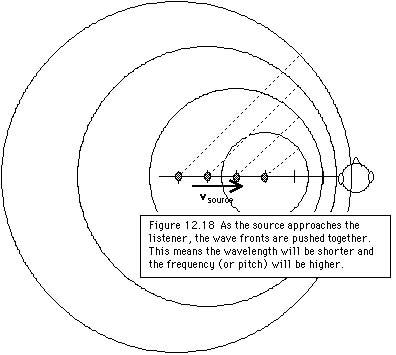|
|

|
|

Why does the pitch of the siren change as the ambulance comes
toward you or goes away from you? Figure 12.18 shows a sound source
approaching a listener. Sound waves made by the source move out
in spherical wavefronts, centered on the position of the source
when the sound wave was created. The sound source is moving with
a velocity of vsource to the right as shown
in the figure. That means the wavefronts that arrive at the listener's
ear are pushed together. They arrive more frequently that if the
source were stationary; they arrive with a greater frequency,
a higher pitch, or a shorter wavelength.

Figure 12.19 shows a sound source moving away from a listener.
Again, the sound waves made by the source move out in spherical
wavefronts, centered on the position of the source when the sound
wave was created. The sound source is moving with a velocity of
vsource to the right as shown in the figure.
That means after a wavefront arrives at the listener's ear the
next wavefront arrives from a greater distance so the time between
wavefronts is now longer. Wavefronts arrive less frequently that
if the source were stationary; they arrive with a lower frequency,
a lower pitch, or a longer wavelength. All this is known as the
Doppler effect.

The Doppler effect describes the change in frequency and wavelength due to relative motion between a wave's source and its detector. If the detector (a listening ear for sound waves) is moving toward the source, the detector will encounter wavefronts more frequently than if it were still and will find a greater frequency, a higher pitch, or a shorter wavelength. If the detector is moving away from the source, the detector will encounter wavefronts less frequently than if it were still and will find a lower frequency, a lower pitch, or a longer wavelength.
The ideas behind the Doppler effect apply to all kinds of waves.
We will learn later that light and radio waves are electromagnetic
waves. A highway patrol "radar gun" sends out radio
waves and then listens to the echos. The frequency of the echos
which are reflected by cars on the highway depends upon the velocity
of the cars. Careful measurement of the frequency of the reflected
radio wave (or radar beam) can determine the car's speed.


|
|